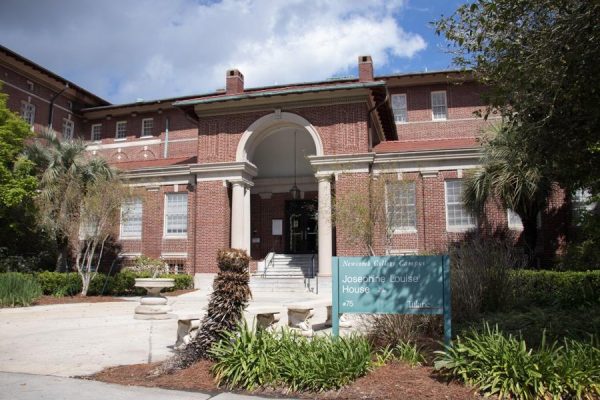
Tulane University, like many historic colleges, initially designed its campus with only able-bodied students in mind, posing challenges for future students who use mobility aids such as wheelchairs and scooters.
Tulane’s Goldman Center for Student Accessibility and the Office for Campus Accessibility aim to support these students. According to the Goldman Center’s website, they “seek to eliminate barriers, advocate for inclusion, and ensure access for every member of our community.”
“[Accommodations] can include walkthroughs of class schedules, moving classes to accessible locations, offering priority registration to allow for adequate time between classes and adding accessible furniture,” said Andrea Vassar, the executive director for campus accessibility.
Despite the Goldman Center’s efforts, many disabled students still encounter challenges on campus.
Juliet O’Hara, president of the Tulane Disability and Access Coalition, describes the hardships she faced as a student while using a wheelchair.
“At one point, I ended up falling out of my wheelchair because [the ramp outside of the Malkin Sacks Commons] was too steep,” O’Hara said. “It’s very hard to walk from class to class when I was on a cane because the buildings are so far apart.”
Many of the older buildings at Tulane — Tilton Memorial Hall, Josephine Louise Hall, Aaron Residence Hall, Warren Residence Hall, Dinwiddie Hall and Norman Mayer Building — lack elevators, posing a barrier for disabled students.
First-year Ryan Nelson describes his experience using a mobility aid at Tulane’s new student orientation in Tilton Hall, constructed in 1902.
“[Tilton Hall] has ramps to enter up in front, but there’s no elevator [inside], so it’s pretty much a useless ramp that just gets you into the lobby,” Nelson said. “I almost missed half of the [orientation] meeting because I couldn’t find a way to get up there until I finally just decided I’m gonna have to go up the stairs slowly. That was really frustrating.”
Josephine Louise Hall, constructed in 1887, lacks both elevators and ramps.
“Jolo is pretty much off limits,” Nelson said. “My friends might invite me over to their dorm, and I can’t go because it’s up multiple flights of stairs.”
“Last year, my friends lived in Jolo. I would be forced to either leave my scooter outside and risk it getting stolen or broken, or seeing my friends,” Tulane sophomore and mobility aid user Oliver Scheier said. “And I went and saw my friends, obviously, but it was a decision that I would prefer not to have to make, and there must be a way around it.”
Many find inaccessibility to be isolating at times.
“It made it harder to connect with people. I think it also just made me feel like I wasn’t seen,” O’Hara said.
Some students would like to see elevators, ramps, spacious and flat sidewalks and more conveniently placed accessibility door buttons on the campus to make it more accessible.
“There’s a lot of doors on campus that have the accessibility buttons. Some don’t, which is a problem in and of itself,” Nelson said. “Some of them that do put them so far I have to do a full circle to get back through the door and hope it doesn’t close in close before I get through it.”
“I would love to see more physical accessibility in the buildings. I don’t want someone to have to get injured or have trouble like getting to class when it’s supposed to be such a simple thing,” O’Hara said.
Despite accessibility weaknesses on campus, there are also strengths.
“There are so many aspects of the campus that work so well and really make my life very fluid and to the point that I don’t even have to think about my own accessibility. I just exist,” Scheier said.
Many students report positive experiences with Goldman staff and Tulane professors’ responses to disability accommodation needs.
“I would say all the staff I’ve interacted with have been really accommodating,” Nelson said. “There are a lot of staff who think of it ahead of time and make it so that I don’t have to be the one making my own accommodations, which is really nice.”
“I have a lot of people that I contact when things such as an accessible door won’t open. I text him and I say, ‘Hey, just want to let you know.’ And they get it fixed right away,” Scheier said.
The Goldman Center hopes to eventually have all Tulane buildings comply with the 2010 Americans with Disabilities Act standards.
The ADA sets accessibility standards for newly constructed or altered facilities.
“While full ADA compliance is the goal, it can be challenging on a campus with historic buildings and shared infrastructure, such as public sidewalks,” Vassar said. “The Office for Campus Accessibility works closely with Campus Services to provide input during strategic planning.”
The Avron and Wendy Fogleman and Bayou residence halls, set to open in 2025, are a part of the strategic planning and will include many accessibility features for disabled students.
“The new residence halls are being built in compliance with current building codes and the 2010 ADA Standards for Accessible Design. This includes features such as roll-in showers, grab bars and strobe emergency alarms in some rooms,” Vassar said.
The Goldman Center and the Office for Campus Accessibility also partnered with University Transportation Services last fall to improve transportation on campus. The Tulane TransLōc On-Demand transit app expanded pickup and drop-off locations to all Tulane-affiliated locations.
The Office for Campus Accessibility encourages student input in order to improve the campus.
“Accessibility is a shared responsibility, and the campus community is encouraged to report any accessibility concerns via our website,” Vassar said.
“[On the] Tulane campus and the rest of the world, there are places for improvement,” Scheier said. “But what I think one of the best things that Tulane does is listen.”




Leave a Comment